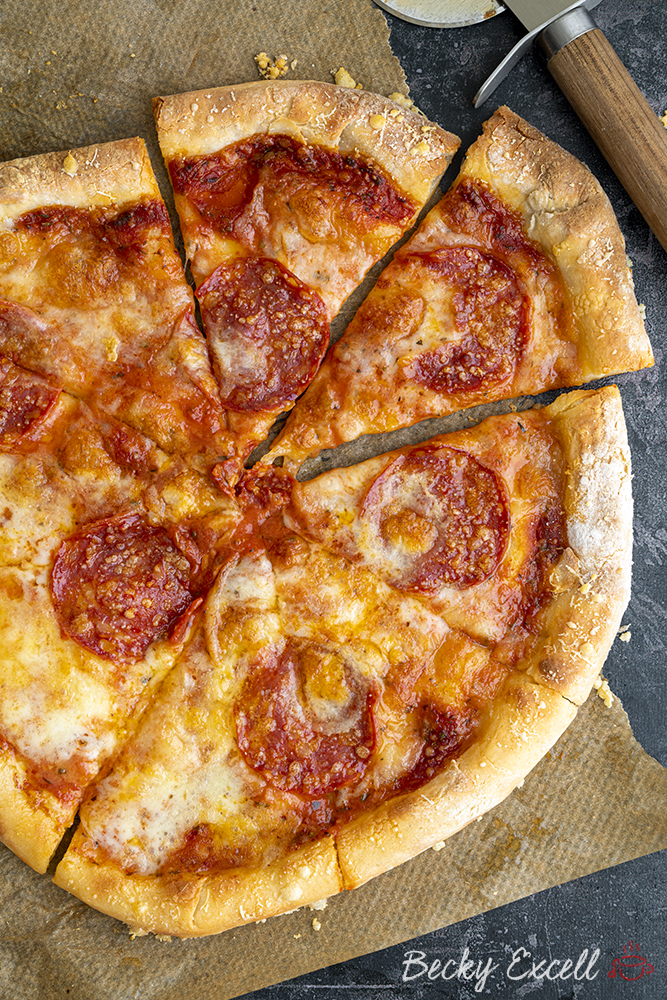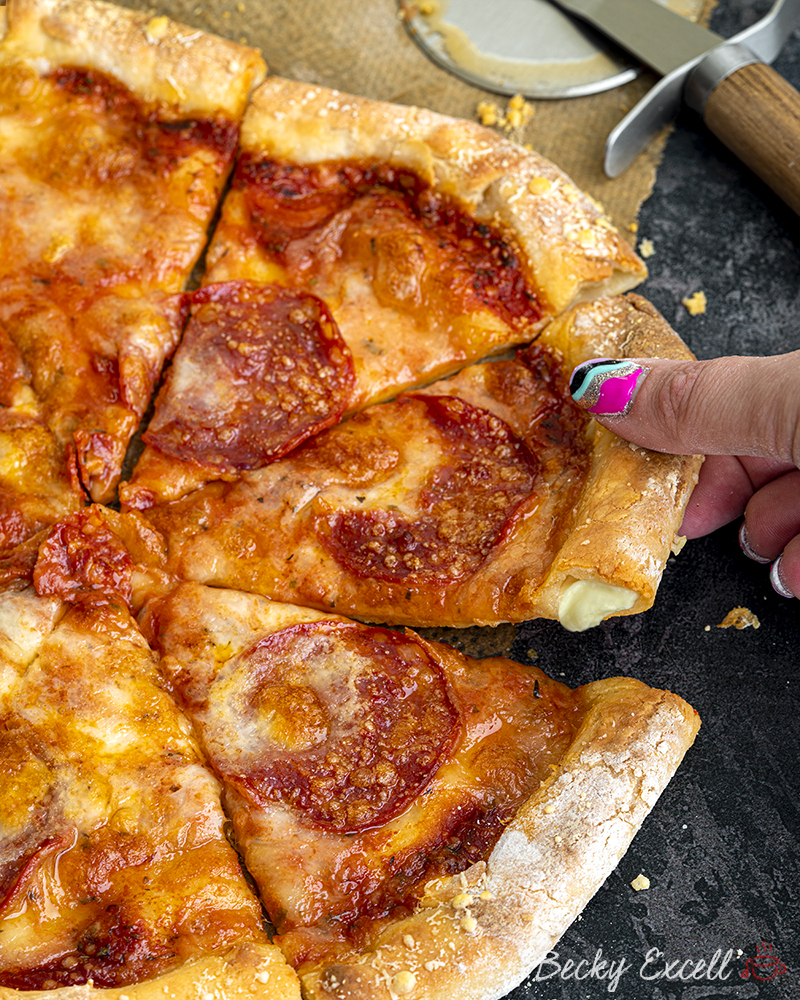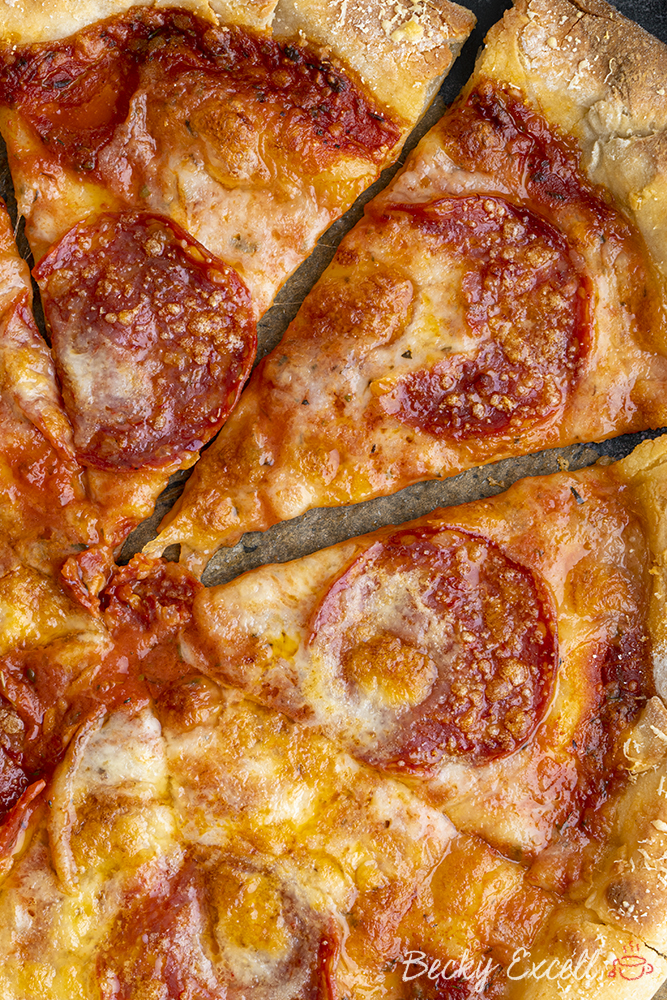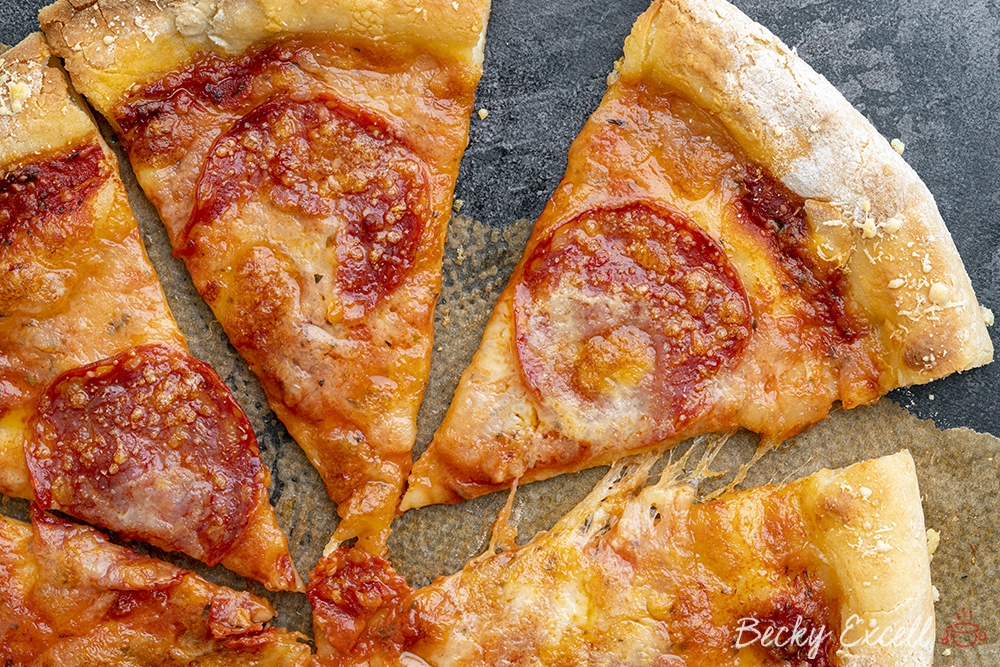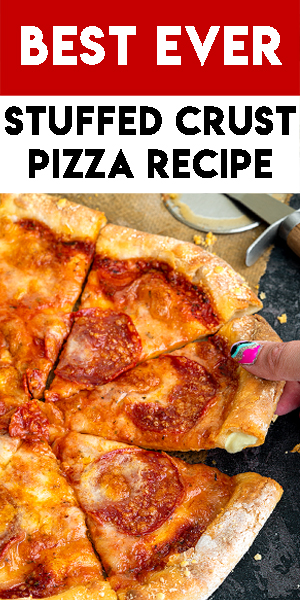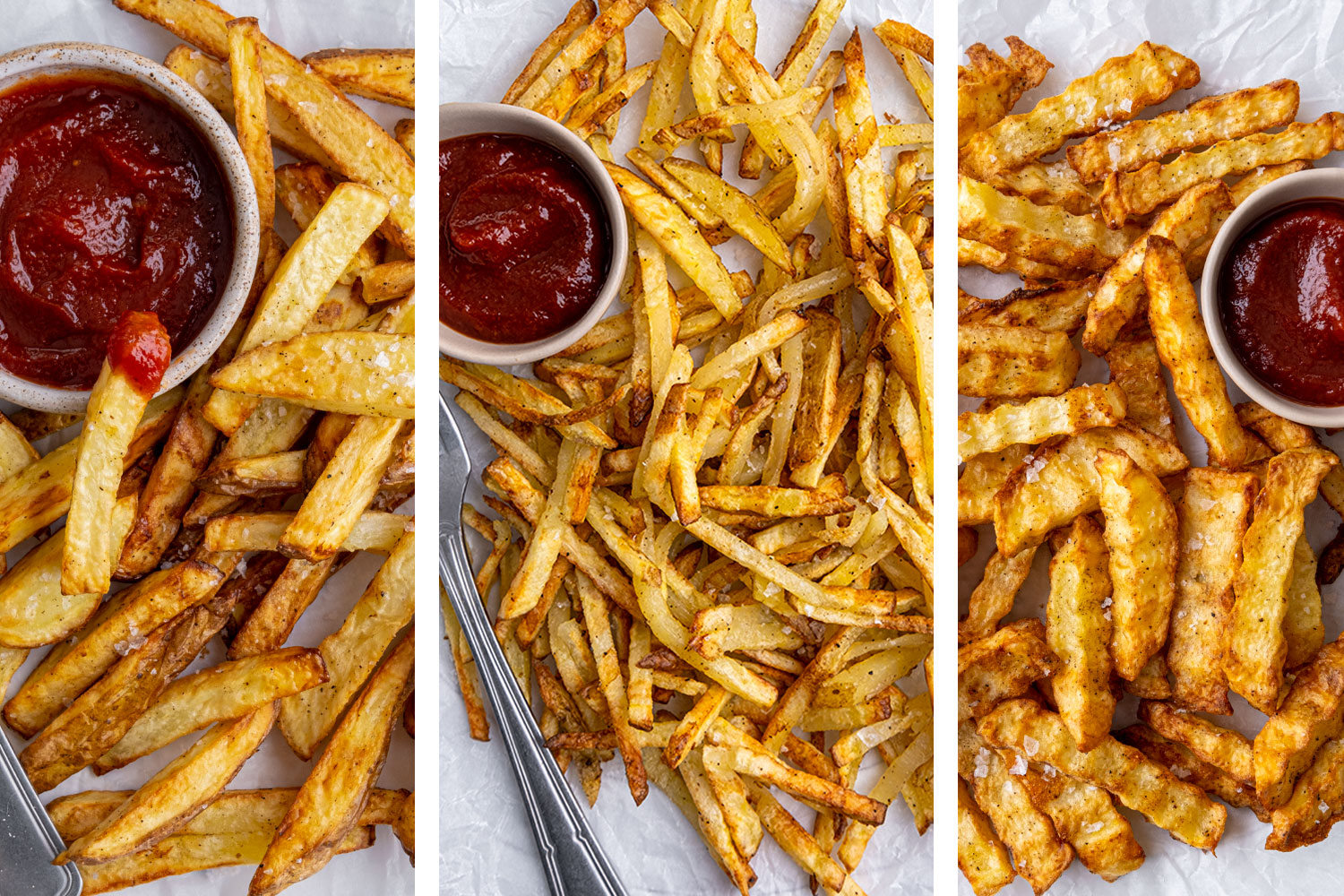Gluten-free stuffed crust pizza recipe – a wonderfully crisp pizza base, with a cheese-filled crust, made using my 3-ingredient pizza dough. You’d never know it was gf!
Gluten-free stuffed crust pizza recipe, anyone? You simply CANNOT find a gf pizza like this out in the wild… so why not make it at home instead? It’s low FODMAP and easily dairy-free/vegan with a couple of simple swaps.
I’ve been working on my gluten-free stuffed crust pizza recipe for a while!
As you might have seen, I posted my gluten-free pizza base recipe a few months ago – it’s made me so happy to see so many of you guys enjoying it.
And I’m sure you guys have been no doubt appreciating how easy it is to throw together!
Fortunately, this recipe is just as simple – it simply involves adding chunks of cheese to the crust and folding over the dough to ensure it doesn’t ooze out in the oven. But don’t worry, I’ll tell you exactly how to do it!
So what does my gluten-free stuffed crust pizza taste like?
The base is lovely and crisp, thin and light and if you’re a crust dodger… you might want to rethink that way of life right now! Why?
Well, the crust on this is the best part! Not only is it super crisp, it’s lovely and cheesy in the middle – perfect for dipping too!
Throw on whatever toppings you fancy and you’ve got yourself the ULTIMATE gluten-free pizza – one you’ll certainly never see at Pizza Hut or Dominoes within the next decade.
Here’s everything you’ll need for this recipe – consider it your shopping list! Keep scrolling until you see the recipe card for the measurements and method ??
Gluten-free stuffed crust pizza recipe: Ingredients
For the pizza base
- yoghurt (thick yoghurt – i use thick lactose free greek yoghurt but any will work)
- gluten free self raising flour
- xanthan gum (can omit if you’re flour contains it, but if you have it, add it in anyway!)
- gluten free baking powder (optional)
- salt (optional)
For the stuffed crust
- mozzarella or cheddar (I prefer cheddar!)
For the pizza topping
- passata
- oregano
- garlic infused oil
- salt and pepper
- cheese (regular, dairy free, vegan or lactose free – whatever you usually have. I use mozzarella on top and a hard cheese like parmesan to sprinkle on the crust)
- pepperoni (I use a low FODMAP one from Sainsbury’s)
And here’s a few answers to some frequently asked questions, as well as a few tips and product recommendations for this recipe. Hopefully this will help you to make this recipe perfect, first time!
Can I make this recipe gluten free? Is it suitable for Coeliacs?
It is gluten free, though nobody would know just by tasting it – trust me!
Bear in mind that minimising cross-contamination is hugely important if you’re Coeliac or making this for someone who is. Here’s some tips from Coeliac UK on minimising the risk of cross contamination.
Also, make sure that all ingredients used don’t have any gluten-containing ingredients. Then make that that they also don’t have a ‘may contain’ warning for gluten, wheat, rye, barley, oats (which aren’t gf), spelt and khorasan wheat (aka Kamut).
Here’s some more info from Coeliac UK on identifying safe gluten free products.
Is your gluten free stuffed crust pizza recipe dairy free?
Yep, this recipe can easily be made dairy free! Simply use dairy free yoghurt – I used Koko dairy free plain yoghurt and a good dairy-free cheese that melts well.
Can I make this recipe vegan?
It is vegan if you use dairy free yoghurt and dairy-free cheese!
Is your gluten free stuffed crust pizza recipe low FODMAP?
Yes! You can easily make this low FODMAP by using lactose free plain or greek yoghurt – that way, it’s suitable for the elimination phase of the FODMAP diet and all other phases too.
Ensure you use lactose-free cheese, or stick to the recommended serving size of regular mozzarella/cheddar cheese according to Monash – 40g.
Of course, ensure all toppings used are low FODMAP. We use this no onion/garlic pepperoni from Sainsbury’s.
Is this recipe nut free?
Yep, this is a nut-free recipe as far as ingredients go, BUT make sure you check the ingredients label on ALL the products you use just to be safe.
Even if the products don’t contain nuts, they may have a ‘may contain nuts’ warning due to being produced in a factory that handles nuts.
You can never be too careful so always read the labels on everything first.
What yoghurt should I use for this recipe?
I would recommend only using Greek yoghurt for the dough – that’s what I always use. It’s lovely and thick and using a runnier natural yoghurt for example, will likely mean you’ll need to add more flour.
Make sure it’s ‘Greek Yoghurt’ and not just a ‘Greek-style yoghurt’ which isn’t nearly as thick.
If you want to keep this vegan and dairy free simply use Koko dairy free plain yoghurt.
Do I need any special equipment to make your gluten free stuffed crust pizza recipe?
Not especially, this is a simple recipe in every way! Having a rolling pin like mine makes this recipe a doddle because you can adjust how thick you want the dough too. No more guesswork!
I can’t buy gluten free self-raising flour where I live, can I use gluten free plain flour?
If you use gluten free plain flour, then the baking powder and xanthan gum go from being optional to mandatory. Gluten free self-raising flour naturally has a little xanthan gum and baking powder (usually) in it but gluten free plain flour doesn’t, so make sure you add your own.
Can I make this recipe without xanthan gum?
As I said, there’s a little xanthan gum in self-raising flour already that will help to replace the gluten in regular flour. So in a sense, yes you can skip adding more xanthan gum, though I always make mine with it just to be safe. It really helps the texture!
But if you wanted to make this with gluten free plain flour and no xanthan gum, then you’re on your own – I wouldn’t recommend it!
Can I make this recipe using other gluten free flours like buckwheat flour or coconut flour?
There’s a big difference between ‘gluten free self-raising flour’ and a *singular* type gluten free flour. When I say ‘gluten free self-raising flour’ in a recipe, I mean a BLEND of gluten free flours, not just one, singular flour.
Most gluten free flour you buy in the supermarket typically contains a blend of rice flour, potato flour, maize flour, tapioca flour AND buckwheat flour. That’s a lot of different flours!
So to replace it with just one specific type of flour… that’s not going to cut it at all. Definitely go for a gluten free flour blend.
Do I need weighing scales to bake your gluten free stuffed crust pizza recipe?
In short… yes, yes and yes! And I wouldn’t advise attempting any of my recipes without them. One of the worst things you can do in any baking recipe is alter the quantities by mistake or on purpose.
A lot of work went into fine tuning ratios and quantities so I wouldn’t mess around with them unless you really know your stuff. I’d recommending using digital cooking scales like these so you know you’re getting an accurate measurement.
How long can I keep your gluten free stuffed crust pizza for?
It’s best eaten fresh as it will start to lose its crisp, freshly baked exterior unless eaten a few hours after baking. However, you can keep it in an airtight container in the fridge for up to 3-5 days.
Simply reheat in the oven at 200C for 5-10 minutes from chilled. When it has got back it’s slightly crisp exterior, it’s ready!
Can I freeze your gluten free stuffed crust pizza?
You can keep it in the freezer in an airtight container for up to 2-3 months with or without toppings.
When you want to eat it, you can cook it straight from frozen by placing it into the oven on a baking tray at 200C for 10-12 minutes. Again, when it’s got back its crisp exterior, it’s ready to eat!
Can I freeze your gluten free stuffed crust pizza dough?
Yes you can! And to be honest, this is probably better than freezing the finished product as they will ALWAYS come out better when freshly baked.
Simply pop your dough into an airtight container and freeze for up to 2-3 months. I like to freeze my dough ready-portioned out in 2 separate containers so I have the option of defrosting as much or as little dough as I like at a time.
Simply pop in the fridge and allow to defrost overnight, or leave at room temperature for 5 hours. If you freeze one huge ball of dough without portioning it out, it will of course take much longer to defrost.
Can I reheat them in the microwave?
You can, but I wouldn’t recommend it. They’ll lose their crisp exterior! Of course they’ll still be lovely and soft and flexible, but I’d always recommend reheating these in the oven instead.
Can I reheat your gluten free stuffed crust pizzas in the oven?
Yes! This is the best way to do it, whether your gluten free stuffed crust pizzas are chilled or frozen. Simply place them onto a baking sheet and pop them into the oven at 200C for 5 minutes from chilled or 200C for 10-12 minutes from frozen.
Troubleshooting
My dough was too wet and sticky to roll. What should I do?
Firstly, it’s supposed to be a little sticky as a formed dough in the bowl. As long as you’re able to bring it together into a ball, when you start rolling it out on a floured surface, the extra flour should make sure it doesn’t stick to your surface, hands or rolling pin.
There’s only two main ingredients here (yoghurt and gf flour) so measuring them out correctly is really important. It’ll stop you from adding in too much yoghurt in the first place and making the dough too wet!
But of course, if you have added too much yoghurt by accident, you can always just add a little extra flour until it’s the correct consistency.
My dough was too dry and cracked and crumbly.
If the dough seems a little crumbly in the bowl, get it out of the bowl and knead it on a floured surface first before adding any extra wet ingredients.
This will ensure that it’s truly combined and there isn’t any yoghurt not properly mixed in at the centre of the dough. If you measured out all of your ingredients accurately, you should avoid getting dough that’s either too dry or cracks and crumbles.
How do I stop my dough sticking to the surface / rolling pin?
Make sure you roll out your dough on a well-floured piece of non stick baking paper and also flour your hands and rolling pin. It’ll make all the difference! This pizza doesn’t need to lifted into a frying pan, only onto a baking sheet so it’s easier!
Can I print your gluten free stuffed crust pizza recipe?
Of course! Just hit the print button located on the recipe below ?? (otherwise you might end up printing this entire post which would probably make your printer go into early retirement)
Gluten-free stuffed crust pizza recipe: Method
Oh and here’s a printable version of my gluten-free stuffed crust pizza recipe. Please remember to give it 5 stars if you tried it and enjoyed it as it helps people know it’s worth trying too! ⭐️ Feel free to leave your written reviews in the comments below this post ??

Gluten-free Stuffed Crust Pizza Recipe (dairy-free/vegan option)
Ingredients
For the pizza base
- 260 g yoghurt thick yoghurt - i use thick lactose free greek yoghurt but any will work
- 250 g gluten free self raising flour
- 1/4 tsp xanthan gum can omit if you're flour contains it, but if you have it, add it in anyway!
- 1/2 tsp gluten free baking powder optional
- 1/2 tsp salt optional
For the stuffed crust
- mozzarella or cheddar I prefer cheddar!
For the pizza topping
- passata
- oregano
- garlic infused oil
- salt and pepper
- cheese regular, dairy free, vegan or lactose free - whatever you usually have (I use mozzarella on top and a hard cheese like parmesan to sprinkle on the crust)
- pepperoni I use a low FODMAP one from Sainsbury's
Instructions
- Preheat your oven to 210C Fan / 230C.
- Add all your ingredients into a bowl and mix together. I initially just do this with a spatula and then as it starts to come together I use my hands to ensure it's all pushed into a big ball.
- Knead the dough briefly so it's smooth and combined (you might need a little flour if it's a bit sticky, it shouldn't be)
- At this stage I sometimes leave my dough for about 30 minutes. It's not necessary to do this but I find the texture of the dough can be even better when I do this!
- On a lightly floured piece of non stick baking paper use a rolling pin to roll out your dough. I roll mine to around 0.5cm thick in a fairly round shape. The thinner the better in my opinion but not too thin that it's fragile! You want to roll it out bigger than usual as you need extra to fold over for the stuffed crust! I probably use about 3/4 of the dough for 1 huge pizza and then the other 1/4 makes a garlic bread!
- If you want to make your pizza to be a certain shape, cut around the edge of it with a pizza cutter (i do this as I can't roll out in a round shape!!)
- Cut up your cheese for the stuffed crust into strips and place it around the edge of the pizza in a circle. Do this about 2.5-3cm (just over an inch) from the edge. You need to give yourself enough of the pizza dough to fold over the cheese to make the stuffed crust.
- Brush inside your cheese all the way round with either water or egg - this works as your glue to hold the crust down. Then carefully fold your dough over the cheese and press down to completely seal. You need to do this otherwise your cheese will escape. A little still might but you don't want it all escaping!! Take your time doing this as you don't want holes.
- Slide your non stick baking paper, with the pizza on it, onto a pizza tray (I have a round one) and cook in the oven for about 5-7 minutes.
- Whilst it's cooking, prepare your toppings. If you want to make a tomato sauce just mix up some passata, oregano, garlic infused oil and salt+pepper. Cut up or grate your cheese and any other toppings too.
- After 5-7 minutes remove your base from the oven, it should have started to colour slightly on the crust. I've only ever had a tiny leakage of cheese and moisture at this point - if you have just leave it on the pizza and put the toppings on top of it, it tastes great.
- Top with all your toppings however you like and place in the oven for 12-15 minutes or until cooked and golden 🙂 My toppings = tomato sauce, mozzarella, pepperoni and pecorino (or parmesan) sprinkled all over the crust!
- Remove from the oven and enjoy!
Nutrition
Any questions about the recipe? Please do let me know by following me on Instagram and leaving me a comment on a recent photo.
If you want to send me a photo of how your creation turned out, you can request to join my Facebook group and post it there. Myself and everyone else would love to see it!
Thanks for reading,
Becky xxx
Oh and don’t forget to pin this for later!

